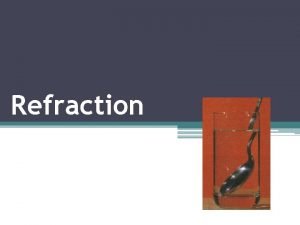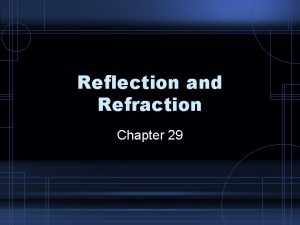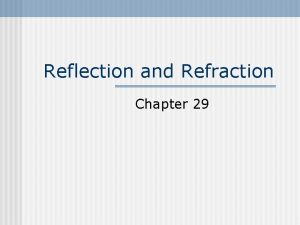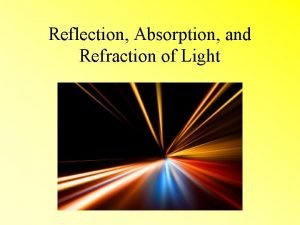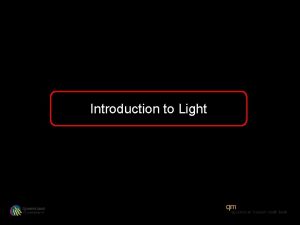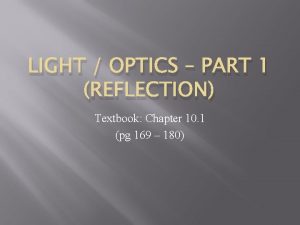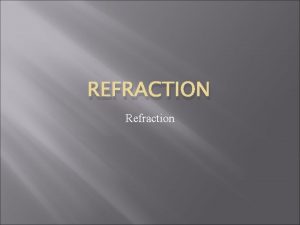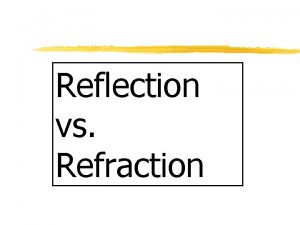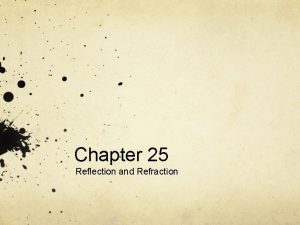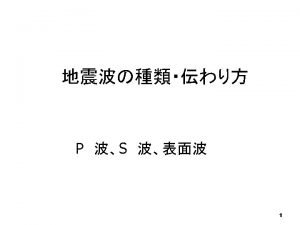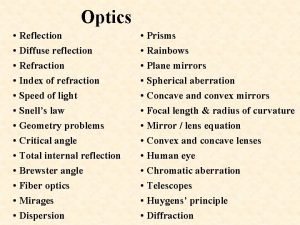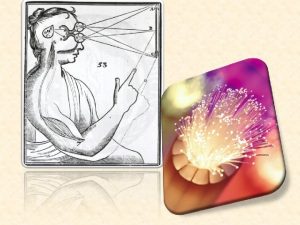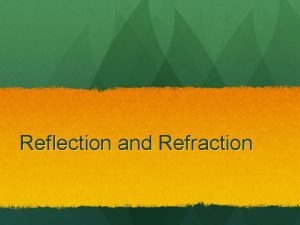Partial Reflection and Refraction Partial Reflection and Refraction












- Slides: 12

Partial Reflection and Refraction

Partial Reflection and Refraction • -is a phenomenon in which some of the light that is travelling from one medium into another is reflected and some is refracted at the boundary between the media

Partial Reflection and Refraction Figure 1 - While looking out of a window, you can often see the reflection of objects inside the room (e. g. your face) as well as objects that are outside of the window.

Partial Reflection & Refraction Figure 2 - Partial Reflection & Refraction: Both refraction and reflection occur, but not equally. The amount of each depends on the angle. In this case, more light is refracted than reflected, as indicated by the thickness of the rays.

Why do we see these images of sunlight and water differently?

Sunlight more refraction A - If light travels from air into water, and the angle of incidence is nearly zero—that is, Sun is almost directly overhead —most of the light penetrates the surface (refracted) and very little is reflected.

more reflection B - As the angle of incidence increases, more light is reflected at the surface and less light penetrates the surface and less is refracted. (for example, at sunset)

What does this diver see while under water?

Divers see what appears to be a light coming through a hole directly above them. reflection refraction • The diver sees a hole of light directly above her. • The light coming from the area directly above you or at a small angle of incidence will penetrate the surface of the water, refract, and be visible to you. • But as the angle of incidence of the light increases, more of the light will reflect off the water, and a smaller amount will refract and be visible to you. Nearly all the light that is coming in your direction from large angles of incidence will reflect from the surface and never reach you. Therefore, from below the surface of the water, it looks like light is coming through a hole.

What determines how much light is reflected vs. how much is refracted? 1) angle of incidence 2) the relative refraction index of the 2 media. critical angle (< c) – is the angle of incidence that produces an angle of refraction of 90°

Partial Reflection & Refraction • When the angle of incidence is smaller than the critical angle, both refraction and reflection occur at the boundary between the two media.

Total Internal Reflection Medium 2 – speed is faster Medium 1 – speed is slower Total Internal Reflection – when the incident light is not refracted but is entirely reflected back into the first medium; -occurs when: i) at angles of incidence that are greater than the critical angle, no refraction occurs. ii) light travels from a medium in which its speed is lower to a medium in which its speed is higher
 Refraction examples
Refraction examples Rainbow total internal reflection
Rainbow total internal reflection Chapter 29 reflection and refraction
Chapter 29 reflection and refraction Reaction poem
Reaction poem Reflection refraction absorption
Reflection refraction absorption Bill nye light
Bill nye light Invictus imagery
Invictus imagery Why can we represent light rays using a ruler
Why can we represent light rays using a ruler Bill nye reflection and refraction
Bill nye reflection and refraction Reflection and refraction venn diagram
Reflection and refraction venn diagram Formula for venn diagram with 3 circles
Formula for venn diagram with 3 circles Lighthe
Lighthe Reflection and refraction learning task 1
Reflection and refraction learning task 1
